Danish Rye Bread (Rugbrød)
This post may contain affiliate links. See my disclosure policy.
This authentic Danish rye bread recipe (rugbrod) is easier to make than you may think. It’s packed with nutrients, has a fantastic texture and old-fashioned flavor and is just plain delicious! Whether you prefer a bolder or milder flavor, you’re completely in charge of that in determining how long you allow the batter to ferment.
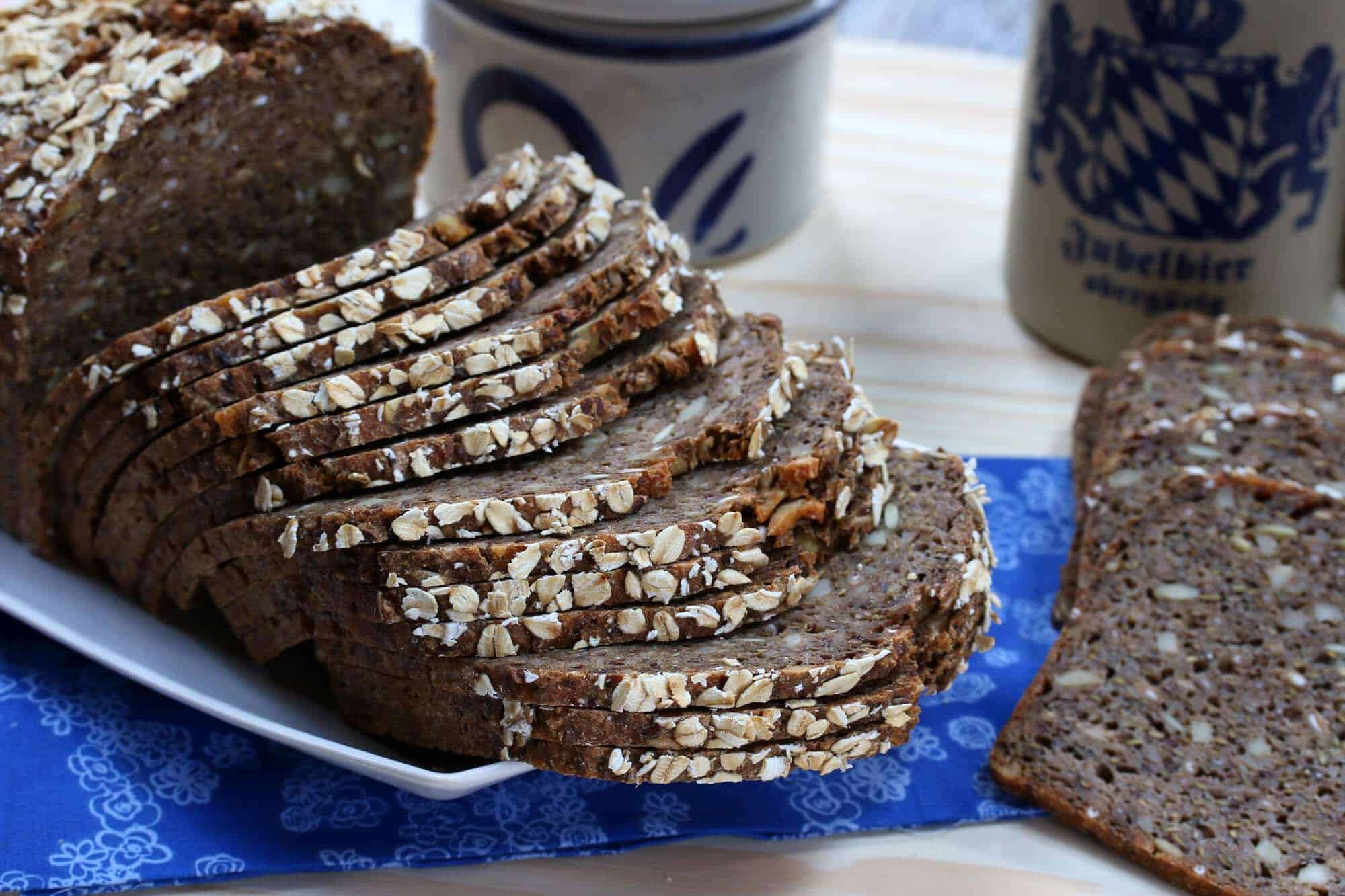
I love breads of all kinds, but there are two kinds that I especially love: Ones that are perfectly crispy on the outside and fluffy on the inside (eg, baguettes) and whole grain breads that are very dense and hearty like the kind I grew up with in Germany (eg, Vollkornbrot, Roggenbrot, Schwarzbrot, etc) and this Danish rye bread.
Smorrebrod
In Germany and throughout Scandinavia dense whole grain breads are particularly popular. You’ll see them served cut up in squares for a variety of hors d’oeuvres (for example, topped with gravlax/smoked salmon, a dollop of crème fraîche or hard-boiled eggs and a sprig of dill), served for breakfast with a tray of sliced cheeses and cold cuts, enjoyed for open-faced sandwiches or simply slathered down with good butter and jam.
In Denmark this rye bread (rugbrød) serves as the basis for their smørrebrød (ie, smorgasbord) wherein it is served buffet style with any number of fine toppings and is also a common accompaniment for many meals. Traditional options include herring, pickled vegetables, liver pate, smoked salmon, and sliced hard-boiled eggs. This Danish Rye Bread recipe is just what you need to create your smorrebrod!
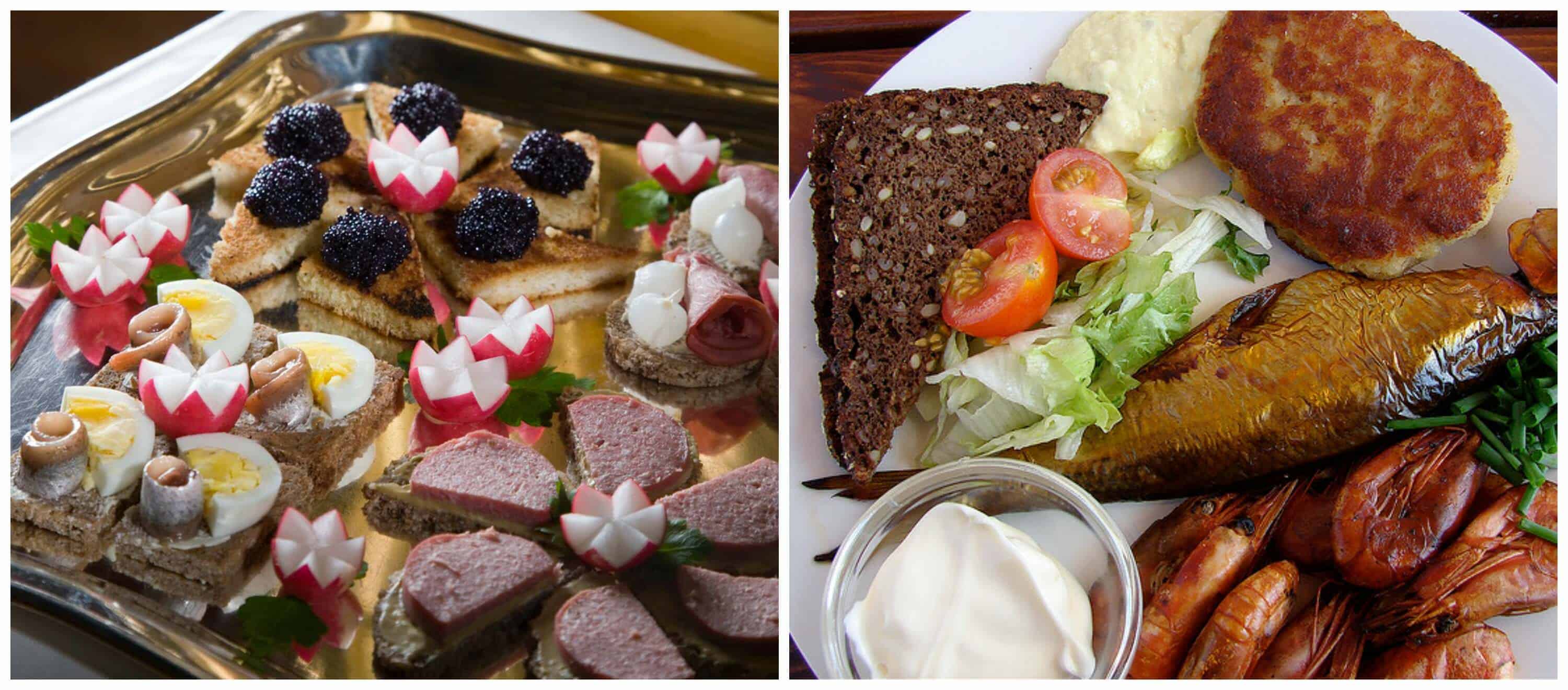
I’ve known many people who have visited Denmark or Germany, fell in love with this type of bread and returned home to their countries unable to find it there. I haven’t been able to find it anywhere here in the U.S. except for German specialty stores and World Market stocks a very small selection of dense German breads. Though specifically Danish sourdough rye bread I haven’t found anywhere here for purchase. The good news is you can make it yourself and I’m going to be posting several recipes for this wonderful style of dense, hearty European bread.
We’re going to start with a favorite among many, Danish Rye Bread. And while this bread is also popular in Germany, it claims particular importance in Denmark, indeed it’s practically one of its national foods, so we’re going to go ahead and ascribe this bread to the Danes. (Plus it will make the maternal side of my husband’s family happy, they’re fiercely proud of their Danish ancestry. And I have some Danish ancestry myself, so we’re all happy.)
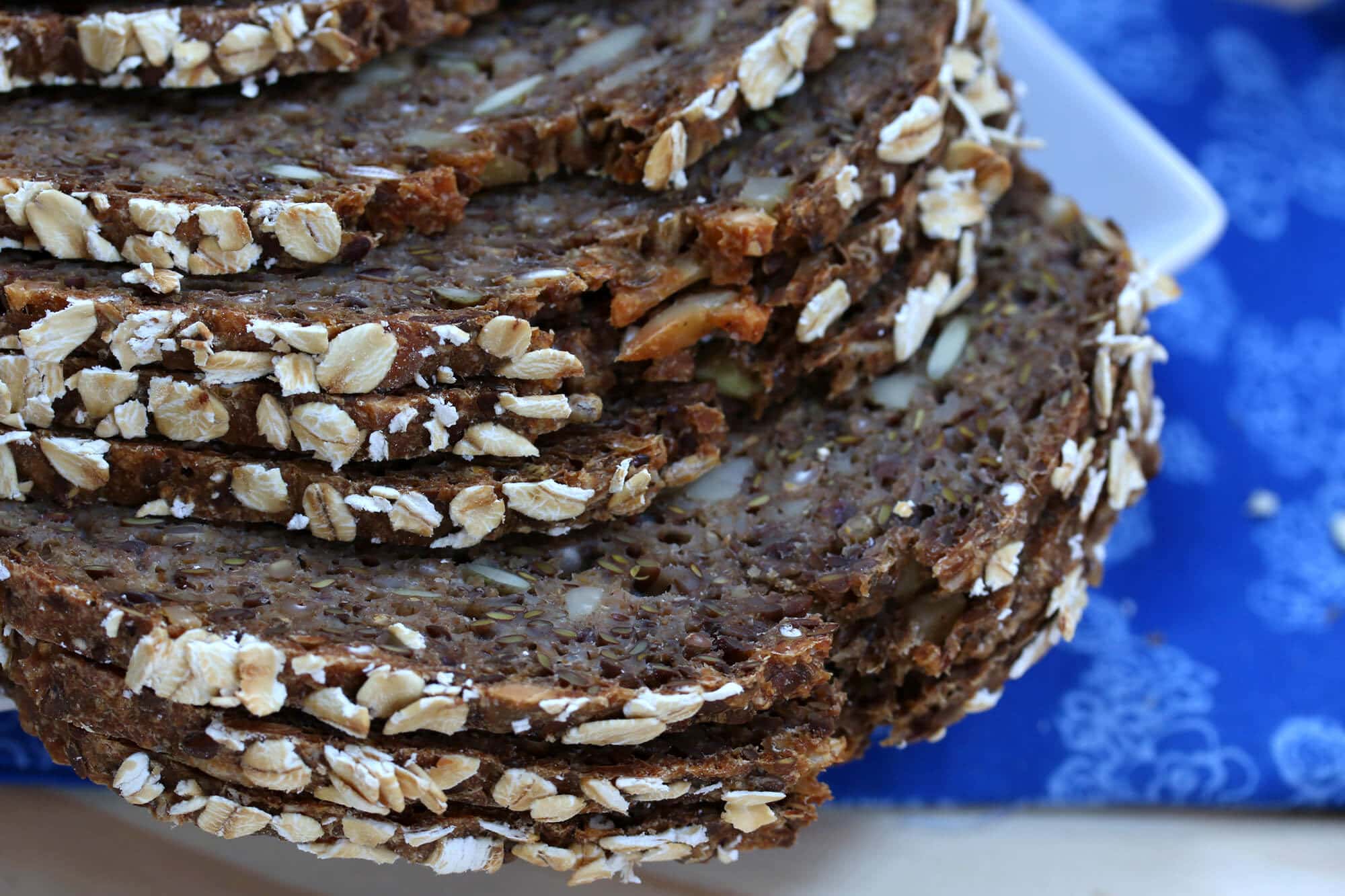
How to Make Danish Rye Bread
Danish rye bread is a sourdough bread that traditionally takes 2-3 days to make. Here is a super simple version that cuts the fermentation time down to as a little as 24 hours without the need to tend and feed it. This version calls for a yeasty beer. Beer and bread are cousins, both traditionally made from the same two ingredients, water and grains. The alcohol in this bread is burned off during the long baking process while the beer contributes to a fabulous texture and consistency (and flavor, depending on which beer you use).
The bread dough is allowed to ferment for 24 hours at room temperature (or 48 hours depending on how sour you like the bread). This fermentation process neutralizes the phytic acid in the grains, a naturally occurring substance that binds nutrients so that the body cannot properly absorb them. Not only does phytic acid acid bind the nutrients of the grains themselves, it binds the nutrients of anything else you eat with the grains. Fermenting the bread dough increases its nutrients and makes the bread easier to digest. And even after sourdough is baked it continues to sour and only gets better in flavor over time.
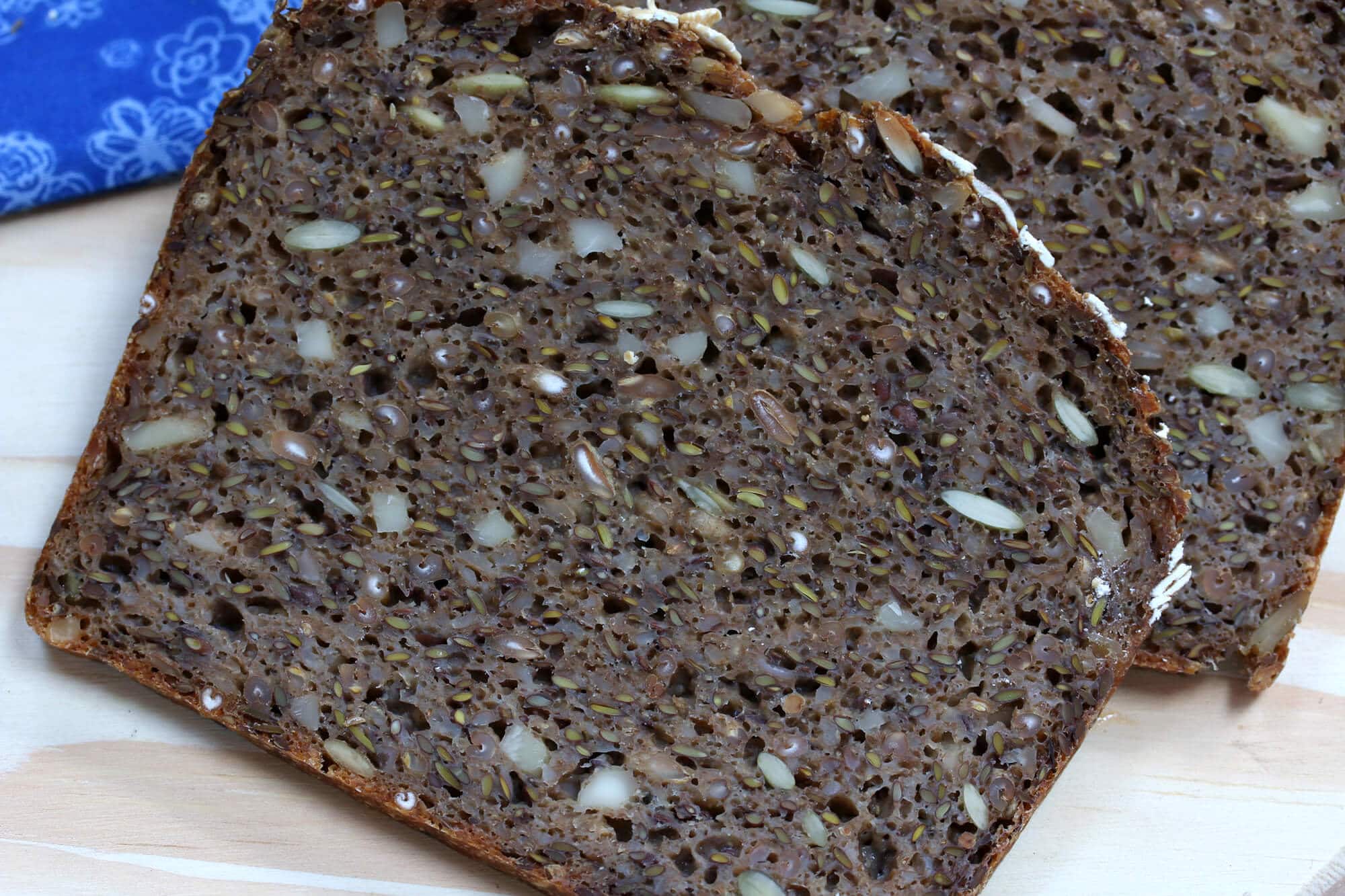
Danish Rye Bread Ingredients
This wonderfully nourishing bread is packed full of whole grains, seeds and nuts. The grains are included in the form of flour (rye and wheat), cracked rye berries and whole rye berries. Tons of similar styled breads incorporate these various forms of whole, cracked, coarsely ground and finely ground grains (eg, spelt, einkorn, wheat, kamut, etc) into the same loaf for a wonderful balance of textures, and that’s where a good grain mill really comes in handy. Not only can you grind your own fresh flour on demand with all the nutrients still intact (as opposed to flour that’s been sitting on grocery store shelves for ages), you can get exactly the kind of grind you need.
I buy my grains all in bulk, take out what I need to last me for a few weeks at a time and store the rest in a dark, cool place. I don’t even buy flour anymore, I grind all of my own flours, cornmeal and make my own baking mixes. For today’s Easy Danish Rye Bread I’m using my German-made KoMo Classic Grain Mill, another stellar example of German engineering and the pride and joy of my kitchen.
With a 12-year warranty, the quality and construction of the KoMo is amazing, plus it’s gorgeous and something you’d want to display on your counter. You can grind your grains as fine or coarse as you like. I use it nearly every day to make my own flours, cornmeal and mixes and cannot recommend it highly enough.
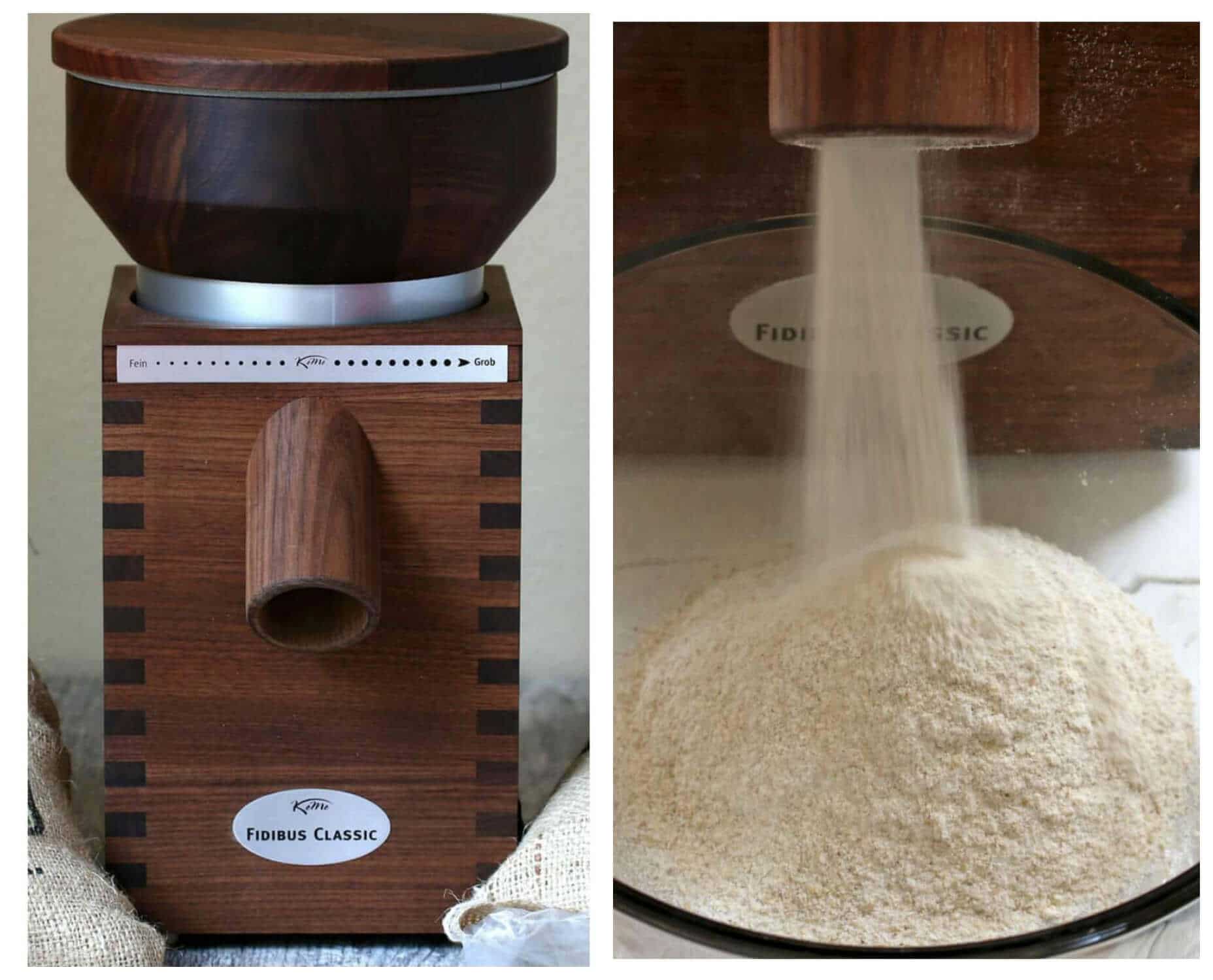
Check out my video below where I talk about some of the KoMo Classic Grain Mill’s features and show it in action in making today’s Danish Rye Bread!
Danish Rye Bread Recipe
Let’s get started!
If you’re grinding your own rye and wheat flour and cracking your own rye berries you’re in great shape! If you don’t have a grain mill you can easily find rye flour in grocery stores and you can “crack” the rye berries yourself by very briefly pulsing them in a good/powerful blender or food processor or smashing them in a bag with a meat mallet or other heavy object.
Combine all of the dry ingredients in a stand mixer bowl. Stir the yeast and sugar into the warm water and let sit for 10 minutes. Add all the wet ingredients to the dry ingredients.
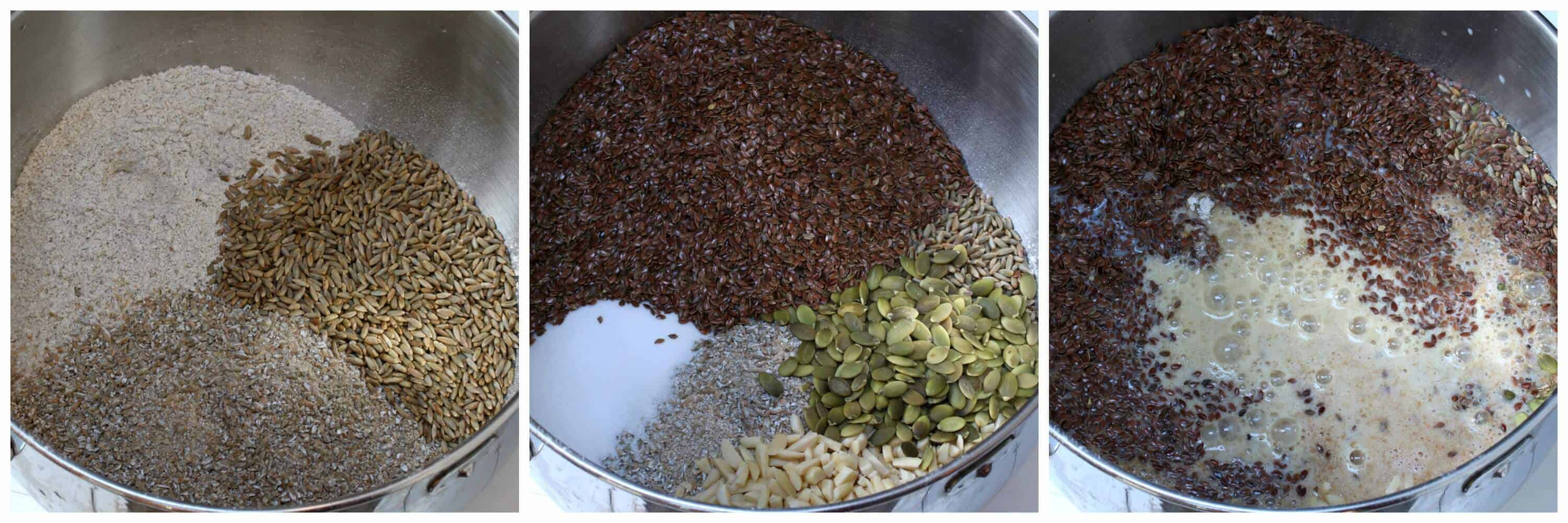
Give everything a stir manually to combine, then attach the dough hook on the stand mixer, set it to the bread setting (#2), and knead for 10 minutes. The dough will be very sticky, loose and not remotely malleable (ie, incapable of being shaped).
Scoop the dough into a very large non-metallic bowl. The dough will bubble up so use a very large, deep bowl with plenty of head room. Cover the dough loosely with plastic wrap and set it in a warm place (ie, room temperature) for 24-48 hours, depending on how sour you want the bread. I’ve done both with great results. If you’re only letting it ferment for 24 hours we recommend first soaking the whole rye berries overnight before using them (drain thoroughly).

After 24 hours the dough will be nice and bubbly with a very gooey texture.
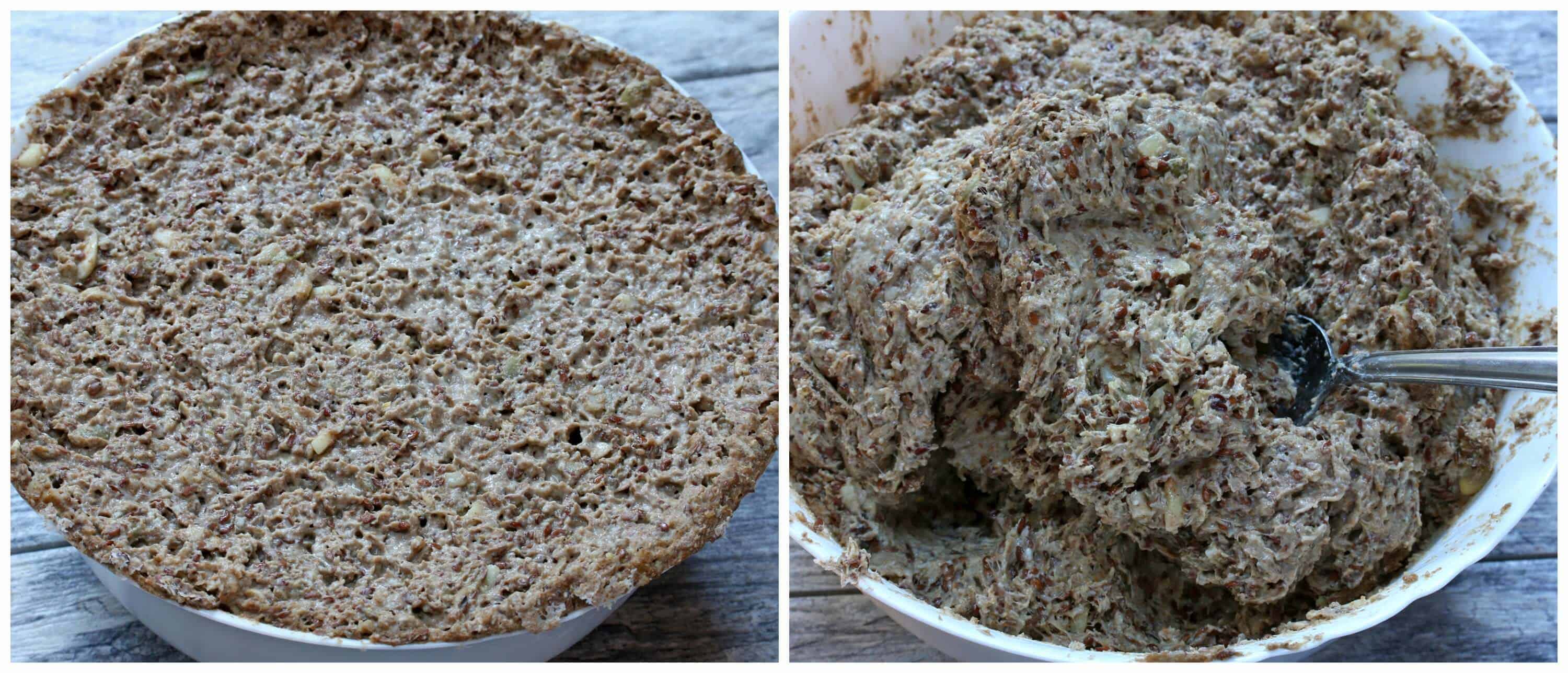
For sourdough it’s recommended that you line your loaf pans so the acid in the dough can’t react with the metal. I use and love the Parrish Magic Line bread pan made of heavy gauge aluminum with straight edges (made in the USA). It’s a 9 x 5 x 3 inch loaf pan.
Scoop all of the dough into the loaf pan, patting it down. It’s a lot of dough but it’ll fit in there, just pat it down (be sure you’re using a 9x5x3 loaf pan). Brush the top with some water and sprinkle some oats evenly over it.

Bake at 350 degrees F for 100-120 minutes or until the center is done. For best and most accurate results use an instant read thermometer and aim for an internal temperature of at least 210 degrees F.
Let it sit for 5 minutes before removing it from the pan. Let the bread cool completely before slicing it. Your rugbrod is ready!
To prolong its shelf life I recommend storing it in the refrigerator or freeze part of it if you know it will take you a while to go through it.
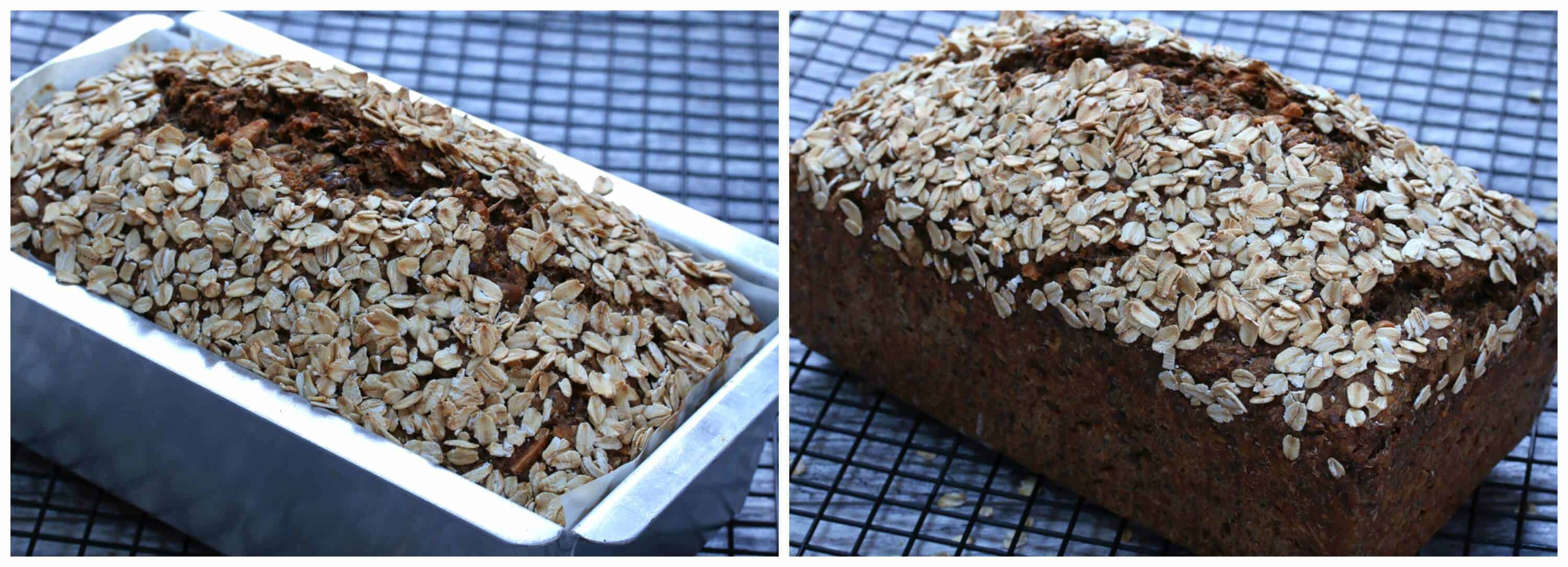
In order to get nice thin, clean slices that look like something you bought at a professional bakery, I recommend a slicer. Chef’s Choice Slicers are consistently ranked at the top and they get excellent reviews. I also use a slicer for meats and cheeses. Whenever I find chunks of cooked ham, turkey or cheese on sale I get those and slice them myself – it’s cheaper than buying them at the deli. At the very least you’ll need an excellent bread knife and for that my favorite knife, hands down, is the Cutco 9 3/4″ Slicer. It glides smoothly through bread and meat like no other.
Enjoy!
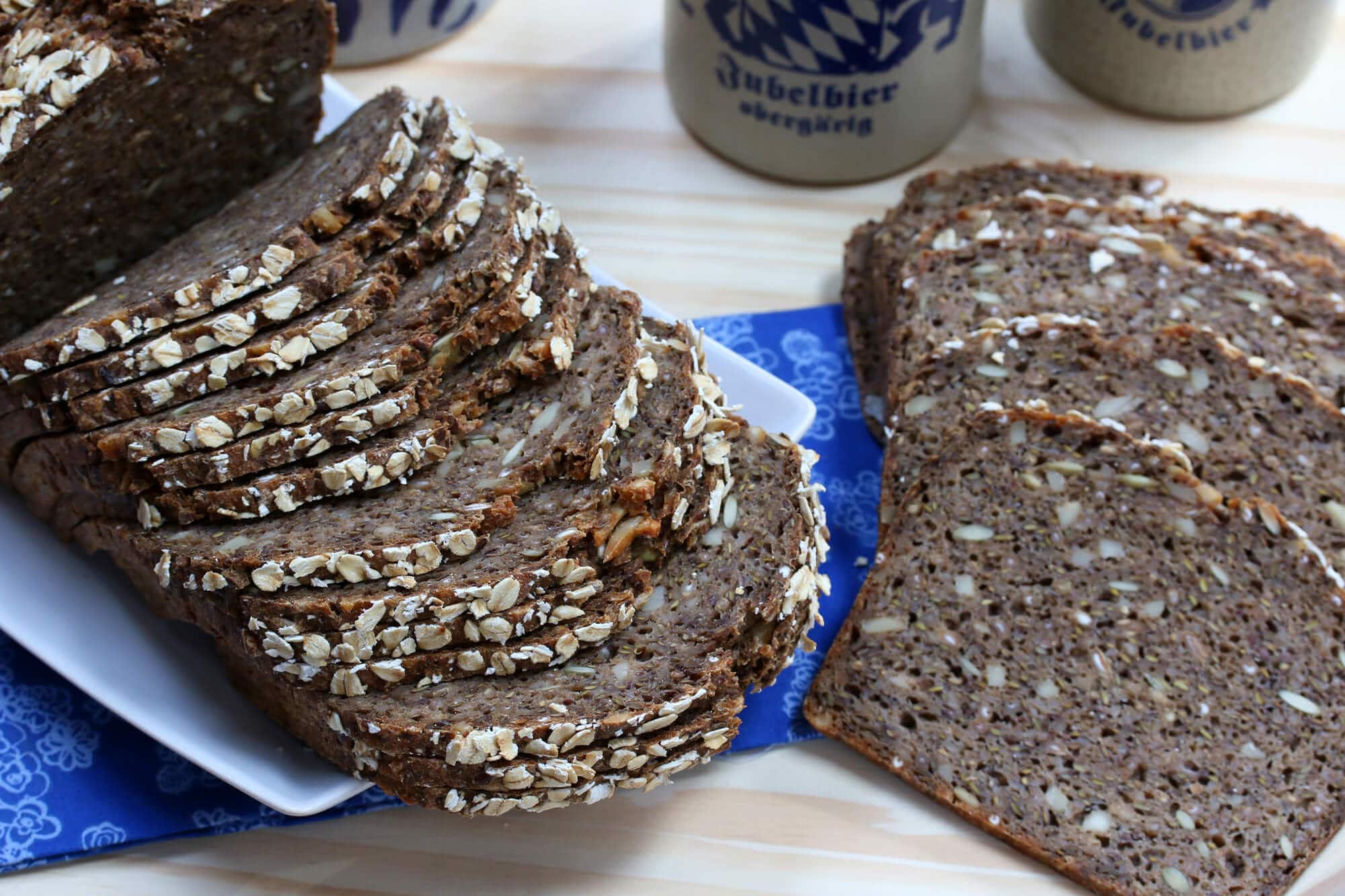
For more delicious breads from around the world be sure to try my:
- German Bread (Vollkornbrot)
- Lavash
- Injera
- Dosa
- Naan Bread
- Sourdough Naan
- Sourdough English Muffins
- Crumpets
- Olive Rosemary Focaccia
- Skillet Cornbread
Save This Recipe
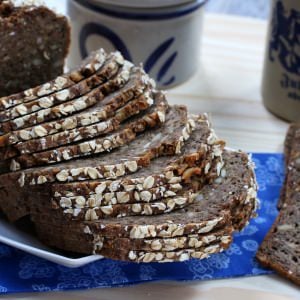
Danish Rye Bread (Rugbrød)
Ingredients
- 2 cups lukewarm water
- 2 teaspoons dry active yeast
- 2 tablespoons sugar
- 2 1/2 cups dark rye flour
- 3/4 cup all-purpose flour
- 1 3/4 cup cracked rye berries (very briefly pulse whole rye berries in a strong blender or food processor until they're broken up into coarse pieces OR smash them in a heavy duty bag with a meat mallet or other heavy object)
- 1/2 cup whole rye berries
- 1 1/4 cup whole flaxseeds
- 1 1/3 cup sunflower seeds or combination of sunflower seeds ,pumpkin seeds and/or chopped almonds
- 3 teaspoons salt
- 1 cup dark beer (see note)
- 1 cup buttermilk or kefir (vegan: 1 cup almond milk mixed with 2 tablespoons cider vinegar) (I often use homemade kefir in place of buttermilk)
- Traditional rolled oats for sprinkling
Instructions
- Stir the yeast and sugar into the lukewarm water and let sit for 10 minutes until the yeast is frothy.
- Combine all the dry ingredients in the bowl of a stand mixer. Add the yeast mixture, beer and buttermilk. Stir to combine.Fit the stand mixer with a dough hook and knead on the bread setting ("2") for 10 minutes. The dough will be very sticky, loose and not remotely malleable (ie, incapable of being shaped).Scoop the dough into a very large non-metallic bowl with plenty of head space (the dough will bubble up). Cover loosely with plastic wrap and let it rest in a warm place (room temperature) for 24-48 hours, depending on how sour you want the bread to be (be sure to ferment it for at least 24 hours to ensure enough of the liquid is absorbed). If you're only letting it ferment for 24 hours we recommend first soaking the whole rye berries overnight before using them (drain thoroughly).
- Line a 9x5x3 inch bread loaf pan with parchment paper (SEE NOTE). Preheat the oven to 350 degrees F.Scoop all of the dough into the lined bread pan, pressing down as needed. (It's a lot of dough but it will fit.) Brush the top with water and sprinkle over evenly with the rolled oats.Bake on the middle rack for 100-120 minutes or until the center is done. For best and most accurate results use an instant read thermometer and aim for an internal temperature of 210 degrees F.Let the loaf cool for 5 minutes before removing it from the pan. Let the loaf cool completely before slicing. Keep stored in an airtight container. To prolong its shelf life I recommend storing it in the refrigerator or freeze part of it if you know it will take you a while to go through it.
Notes
* You can substitute water or more buttermilk for the beer
Nutrition
Originally published on The Daring Gourmet January 28, 2016

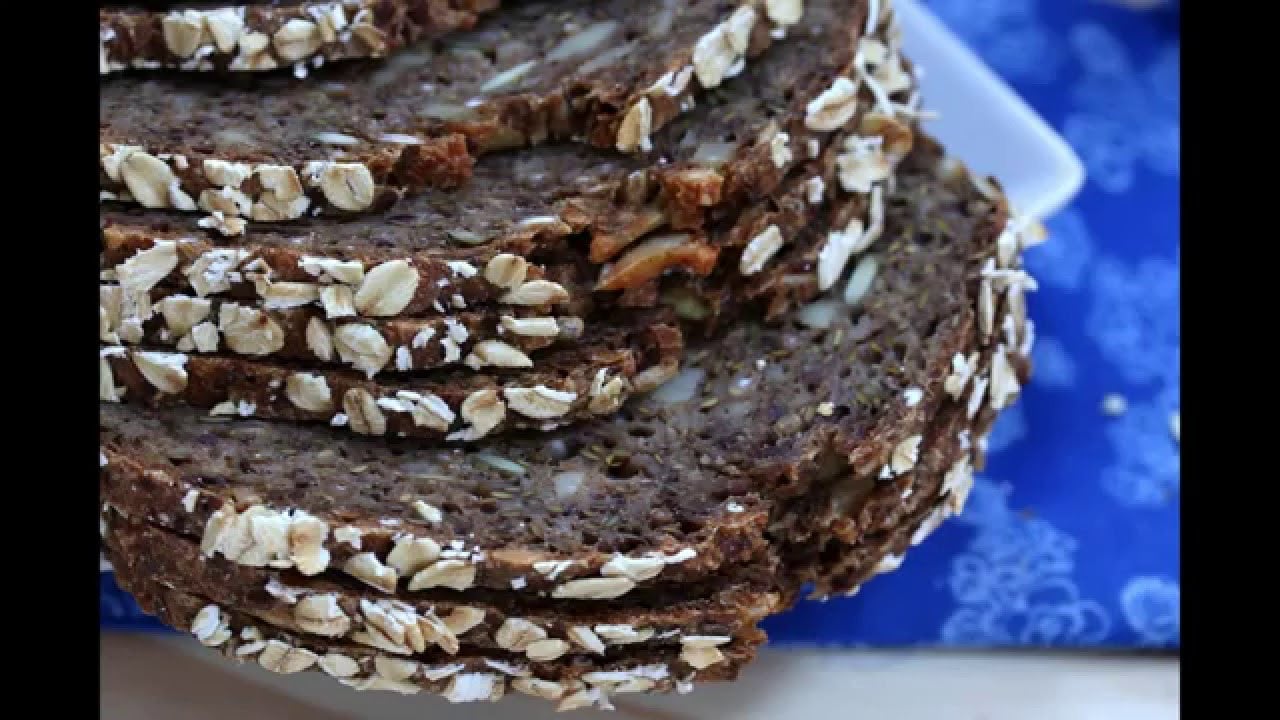


















I just got back from a trip to Denmark and Northern Germany and fell in love with this bread. I knew I had to make it when I got home. I just pulled it out of the oven and had to immediately try a slice. It’s so delicious and just like what I had in Europe. Thanks so much. I’m going to be making this over and over again for sure.
The only thing that is slightly different is this is lighter in color than the breads I was eating. It was almost black in color. Any idea what that would be? I can’t imagine they’d add a caramel color to it.
I’m thrilled to hear that, James – thank you! The color: Rye flours come in dark and light varieties, so that’s one factor that contributes to the final color outcome. Also, some people will commonly add ingredients like molasses or dark malt extract to darken the color. Thanks again for the feedback!
Hi Kimberly, I’m from India..we don’t get good variety of bread here. Your rye bread looks very nutritious and flavourful…I’m so very thankful to you for sharing ur recipe. I’m a beginner and learning to bake..☺️Going to collect all the ingredients, shall post the feedback later on. Many thanks 🙏
Thank you, Mini, I’m so glad you found my site, welcome! I hope you enjoy this bread and yes, please let us know what you think.
Can one substitute alcohol with something nonalcoholic?
Hi Diana, yes, you can substitute water or more buttermilk.
I baked this for an additional 70 minutes and it’s still quite gummy in parts. I converted all of your volume measurements to grams, so perhaps I didn’t have enough dry ingredients? It still tastes great a bit I’m definitely not getting the clean, coherent slices you’ve got in the pictures. Guess I’ll have to try again!
Yeah, I’m not sure, AG, but it sounds like something must have been off in the conversion to grams. After baking this for 160 minutes – over 2 1/2 hours – there’s no way it should have still been so gummy. How long did you let it ferment? The longer it ferments the more liquid it will absorb.
Try putting the pan further to the bottom.
I made two loaves of bread. They turned out so nice I took a picture of them. I followed the recipe, and let it forment 36 hours. Baked for 90 minutes. Cooled completely before slicing. The knife was sticky after slicing. No crumbs. Never made this type of bread. I was a little concerned that it might of not been done. The inside was moist. Is there an internal temp I should be looking for?
Hi Kim, I never check the internal temperature but you’ll probably want to aim for around 190 F. Correct, the bread won’t be dry and “crumby”, that’s normal, and it’s also normal for it to be on the moist side.
Kimberly,
I made your bread and it looks gorgeous, but I had to grind the flax seed because someone in the family has diverticulitis and can’t eat the whole seeds. Can you recommend a substitute for the flax seed? Not sure the ground flax seed is ultimately the best way to go.
Thanks much for the splendid recipe.
Hi Bonnie, have you tried the bread? Ground flax has a pretty prominent flavor but if you like the way it tastes in the bread then that’s all that matters. Alternatively you can simply “up” the amount of the rye berries and sunflower seeds and add some additional seeds like pumpkin seeds to compensate for the 1 1/4 cups flax seeds.
Hi Kimberly, I made a loaf yesterday and it is divine! I fermented it for 24 hours. I like that I can use yeast because I let my sourdough starter go. I used millet in place of the cracked rye; and did not have any beer in the house so I used extra water instead. The dough was very stiff yesterday putting it in the loaf pan and I wondered if it would be good. I thought it may have needed more moisture? I put pumpkin seeds on top and into the oven it went. The millet makes it crunchy and we had nice healthy slices with soup for supper last night. Soooo good! Rugbrod is my fav and I will be making this again and again with variations on the basic recipe. I do grind the flour which I think makes it so tasty and fresh. My question is what could I have used in place of the beer? Thank you for the recipe!
Wonderful, Susan, I’m happy to hear that! The dough is very stiff, yes, but millet also absorbs a lot of water and may have made it even stiffer than normal. The important thing though is that it turned out great and it sounds like it did. There really is no substitute for beer so if you want to omit it I would just recommend what you already did and use water. Thanks so much for the feedback!
Kim, I would love to have your recipe. I’m looking to go as gluten free as possible, and “millet” caught my eye. I don’t care for beer, so “water” also caught my attention. Would you be willing to share?
Help! I followed your recipe exactly . Only replaced rye berries with croaked outs. It’s been 24 hours and the dough hasn’t bubbled at all! If anything it’s getting solid and dry. Have I wasted all of those lovely ingredients ?
Hi Amelle, I haven’t tried it with cracked oats so I’m not sure how that would impact the bread. It may be that they soaked up too much of the liquid, preventing it from bubbling and causing it to dry out. At this point it won’t hurt to try – just pop it in the oven and see what happens.